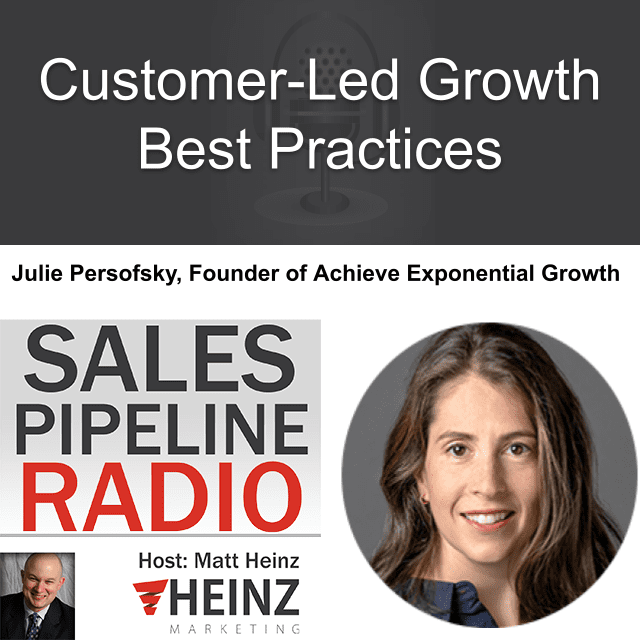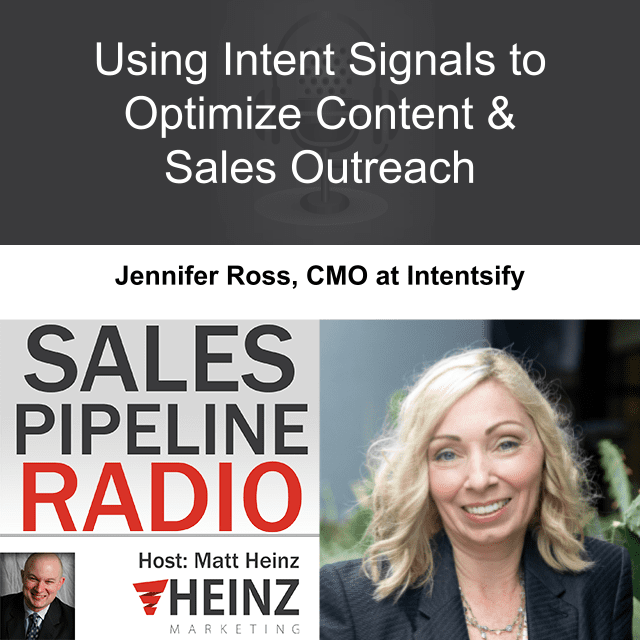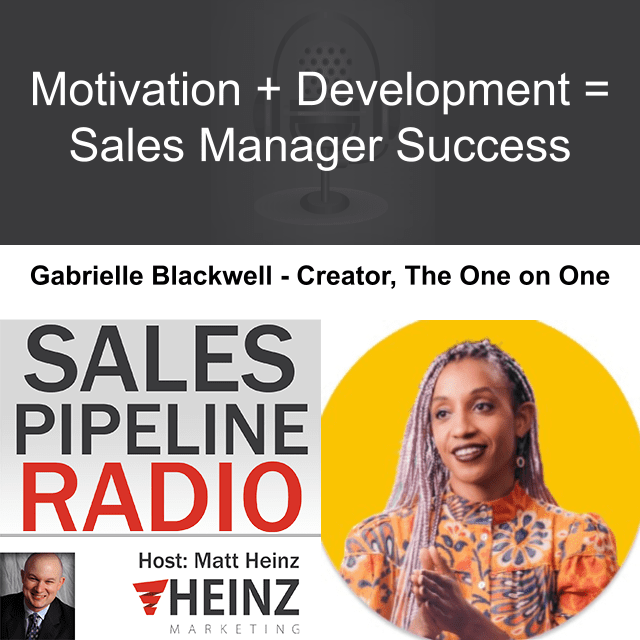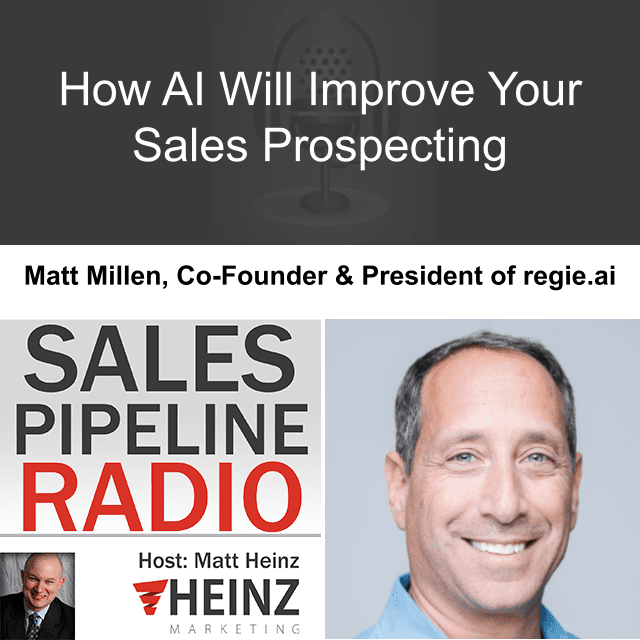Sales Pipeline Radio, Episode 346: Q & A with Julie Persofsky

Summary
Matt interviews the best and brightest minds in sales and Marketing on Sales Pipeline Radio.
By Matt Heinz, President of Heinz Marketing
If you’re not already subscribed to Sales Pipeline Radio or listening live Thursdays at 11:30 am PT on LinkedIn (also on demand) you can find the transcription and recording here on the blog every Monday morning. The show is less than 30 minutes, fast-paced and full of actionable advice, best practices and more for B2B sales and marketing professionals.
We cover a wide range of topics, with a focus on sales development and inside sales priorities. You can subscribe right at Sales Pipeline Radio and/or listen to full recordings of past shows everywhere you listen to podcasts! Spotify, iTunes, Blubrry, Google Play, iHeartRADIO, Stitcher and now on Amazon music. You can even ask Siri, Alexa and Google or search on Audible!
This week’s show is entitled, “Customer-Led Growth Best Practices“ and my guest is Julie Persofsky, Founder of Achieve Exponential Growth.
Tune in to:
- Learn why focusing solely on retention isn’t enough to unlock the full value for both your customers and your business.
- Discover the power of customer-led growth, where your customer base becomes a source of revenue acceleration.
- Explore the three core customer success funnels to create impactful moments and drive growth.
- Harness the potential of advocacy as a sales engine, accelerating deals and building trust in your journey toward customer-led growth.
Watch the video, listen in below and/or read the transcript below.
Matt: All right. Welcome everybody to another episode of Sales Pipeline Radio. I’m your host, Matt Heinz. Excited to have you here for an awesome new episode. If you are listening and watching on demand, thank you very much for downloading, for subscribing. If you like what you hear today, if you like this content, this format, we got a lot more, about 360 episode of Sales Pipeline Radio from over the years, every episode on demand past, present, and future at salespipelinearadio.com.
Very excited today to cover a topic that we have been thinking a lot about this year. And very excited to have someone I consider the, one of the preeminent experts in customer led growth, Julie Persofsky. Julie is an advisor to SaaS companies worldwide, helping them achieve exponential growth and really excited to have her joining us live from Whistler, BC, Canada today. Julie, how are you doing?
Julie: I’m doing great. Thank you so much good to be here.
Matt: I’m excited. We are experiencing a cacophony of something led growth initiatives, right? There’s, there’s event led, there’s partner led, there’s all this and that. So on one hand, I’m like, customer led just adds the mix. However, I’m really excited to see so many companies lean in on the customer experience and thinking of the customers as a conduit and accelerant of revenue, not just in retained revenue, but also net new revenue as well. So when we’ve used the phrase, whether it’s customers that led us to growth or whatever, what does that mean to you? What are we talking?
Julie: Right. So at the end of the day, you have a pool of customers that already use you, already have a budget for you already have hopefully achieved impact from your product or service and they essentially are a pipeline of massive revenue potential through upsell cross sell.
Also making sure that you retain that business is huge. And then the other component is leveraging your customers for advocacy to help you generate new leads, right? So there’s referrals, there’s customer stories, there’s references, and so all of that, leveraging your customer base to fuel your next stage of growth is really where customer led growth comes from.
Matt: A lot of companies focus almost their entire marketing effort on net new growth on acquisition. And if you’re an early-stage company, maybe you don’t have a big customer base and that’s a great place to start. However, many of those companies as they mature, continue to spend the majority of their time, budget, and efforts on acquisition, and they got maybe a newsletter and an 800 number for their customers, how and when do you start to change that balance? And what are the first things companies should do to invest in that customer relationship in a, in a more effective way?
Julie: Yeah. I mean, obviously the first thing you’re going to do is– you need that pool of customers. You’re going to have a customer success team that’s going to be managing your customer base. And that’s the first thing you need to do. And then as you start to grow and get this large group of customers you want to start thinking about it from a marketing standpoint of how are we nurturing them? And you mentioned this list of people that maybe you send an email to once a year.
The most forward-thinking companies today are collaborating with a customer marketer, someone on the marketing team and customer success to think about– if we want our customers to be most successful, what impact do they need to achieve throughout our customer journey?
And actually milestone those moments across year one. And then I like to think about it as year one and then all the time after year one, because that first year is really, really crucial in onboarding steps and adoption and whatnot. And then you think about what are those impact moments that help our customers be successful so they retain?
And then also what are the opportunities to have them grow with us? So whether it’s usage based but also are there new products you can sell to them? So a really good critical time to think about really leaning into, nurture your customer base and marketing to them is when you have products to sell to them because generally speaking, your customer success team is going to be great at helping them use the product, but unless you enable them to sell to your customer base, they’re not going to think about it. They’re not necessarily intended to do that. And that’s not necessarily their skill set.
So we want to shift that to say, here are some ways to think about why you would sell this to your customers. The impact of the greater impact they could achieve. And here’s how and so that’s where the collaboration comes in.
Matt: Companies also invest heavily in thinking through their buying journey. And you talk a lot about customer journey. What are some key stages of that? Cause I think a lot of companies say, okay, like I got this buying journey, they bought and now they just use, right.
But there’s, but there’s more than that. And so how do you think about the nuances of that customer journey and sort of then building strategy and designing an optimal sequence across that journey?
Julie: Yeah. So we’re going to shift our thinking a little bit. Okay. So in sales, you have a marketing funnel, right? You have got all these people that are going through your marketing funnel. Then you generally have your BDR or SDR funnel who makes it through as a qualified lead. And then you have your sales, your actual sales funnel for your AEs. And that’s going to take you through to close each of those different teams or sections have their own funnel and then we kind of think about customer success is anything post sales, but actually customer success has 3 core funnels as well. So, we think about onboarding and onboarding is extremely linear and the easiest 1 to think about as a funnel. And I actually encourage you to think about onboarding as its own funnel.
You have customers come in who have closed won. And what are those steps they need to go through in order to hit first impact and then, you know, full onboarding or graduation. So we can pass it off to the true customer success team. That’s one funnel. Really, if you’re going to take away one thing from an onboarding perspective today, it’s what is first impact?
And I define first impact as that moment where your customer kind of says, like, that’s why I bought. What is that moment? And how do we get them there as fast as possible? Because if it takes really long time, they’re going to start regretting it. Next piece is that customer journey. And that’s going to be, you know, how do we get them to use and adopt your product?
And when I think about the customer, that it’s what are the key moments, right? What basic things like use, what do they need to do in order to get full impact or full value from your product? What are those key moments? And it’s not all at once. You know, sometimes if it’s a very, if you’re trying to change behavior, you could think about it as what are the things they need to do on a daily, weekly, monthly basis in order to make your product habit forming and how can you support that?
One company I’m actually working with we encourage them to set up every single week, set up one thing. Then check it every day, learn from it and report back to your CSM at the end of that week on new insights that you had. And so it’s training them to not just use the product, give them value, but it’s also starting to create that habit for me, you know, where it’s like, okay, you go in, you check your email, you check this product, you move on.
And then the last piece of the funnel is that expansion that growth piece and I like to map it out concurrently with use. So if you think about your customer journey and those core impact moments and order for them to get the most impact from your product, when can you insert expansion opportunities?
And so a really simple way to think about it is you’re probably doing customer business reviews or QBRs or EBRs, whatever you call them anyways, think about theming those EBRs throughout the year and making them really prescriptive and actually inviting certain people from your customers, depending on the content.
So, for example, Three months after onboarding, that’s going to be, Hey, are you set up properly or using it properly? Let’s just sort of do like a little mini health review. Don’t invite your decision maker, right? This is a champion user. The next one could be, Hey, let’s give you some insights about how our top customers get the most impact in the first year.
That’s strategic. Let’s invite some strategic thinkers, let them know what you’re going to cover. And that’s how you start to build out, a very full suite of people engaged in your customer base. So you’re not single threaded. You start to really land in and hone in on impact moments and share some great insights.
Matt: Those impact moments sound really important. And as I think about experiencing as a customer with a lot of companies I use, both personally and professionally I think sometimes there can be a take it for granted kind of feel right. Where like, Hey, they’re in the product. They’re doing fine. Their checks clearing. I think we’re good. Like the reinforcement of the why, right? Like when you buy something, you have high hopes that it’s going to work, but you’re hoping it’s going to work. Sometimes you need that reinforcement, not just as first impact, but ongoing impact.
And it may be beyond just the people using your product. I’m also curious; when you’ve got a user team who are experiencing and using the product, but then you have executive sponsors who may no longer be involved day to day, week to week, month to month, but may make decisions around budget and renewals at some point. How do you keep those folks engaged?
Julie: Yes. So there’s the two main things. I agree. The impact moments are so valuable and something that companies don’t think about. And one of the most important pieces is a company may bought for one reason, right? Maybe it’s awesome cost savings or time, whatever it may be.
But oftentimes there’s other areas, there’s other value drivers that your other customers are getting. And so as someone in the customer success team, and even customer marketing, if you can start to document those different types of impact and capture them in stories or different snippets, it’s a great way to nurture.
Hey, customers like you. Executives like you have been achieving X, Y, and Z from using our products. You want to learn more? And we don’t do that, right? I mean, you said, take it for granted. We often just sort of say, oh, yeah, they’re using the product. They’ll be fine, but really we want them to continue to gain more impact because here’s, what I’ve noticed about customers.
They have this massive pain, which is why they bought in the 1st place, right? But as soon as they start really using your product, that pain goes away and it’s really funny. It’s funny about pain. Like, have you ever had an injury? You forget how much it hurts. And so all of a sudden your customers no longer have that pain.
And so the resonance of the impact you’re helping them achieve is kind of not as powerful as it was when they first started using you. So they almost have amnesia. And then all of a sudden you’re going to raise the prices. Maybe they snap and you maybe had a bug or something and they’ve forgotten how painful it actually was before your product.
So your job is to also kind of like remind them, right? Remember what life is like without us. We are your Mecca. And, in addition to that, we can do so much more.
Matt: Julie Persofsky. She is a longtime advisor to SaaS companies looking to achieve exponential growth and that growth can’t just come from net new sales. The exponential comes in leveraging those customer relationships. Talk about that interplay between successful customers and driving new pipeline.
I think people think of like, okay, I’ve got these customers. My goal is retention. My goal is expansion. But successful customers are leading indicator to health of your net new pipeline. Talk about that connection and how that interplay works.
Julie: Absolutely. And I think the world of advocacy, it’s such a soft concept, right? Oh, now we need advocates. But really, I think it’s fuel your business. I spent five years working for an advocate marketing platform. And part of what was so powerful is they actually create an engine for your sales team, right? So think about if you’re in sales, think about how much faster a deal closes when you can bring in a great reference, how much faster a prospect goes through your sales funnel if it’s been a referral, right?
I think it’s like the stats were like 80 percent faster. Right. And we’re likely to close if it’s come from a referral, we don’t even ask our customers for referrals. So in addition to marketing supporting the world of your customer success team and nurturing our clients and helping them expand and educating them and you know, whatnot, it’s about capturing those advocates and nurturing them to help fuel your sales funnel: asking for referrals.
Ask me if I’ll be part of a reference program, capturing great stories. And I’m not talking about the boring stories that you see on websites, right? Like make them human, right? Talk about the people behind it and the problems they’re solving and some of their interests. So that way you actually want to read more and learn more.
Matt: So who owns this? Because you get a lot of heads nodding, like, Hey, this makes a lot of sense, but you’ve got a marketing team that isn’t staffed for this currently, you’ve got a sales team that’s focused on net new, you’ve got a customer success team that sometimes is mostly reactive and tactical and just really making sure people can use the product, this whole idea of a buying journey and advocacy and creating these moments of impact and communicating them, who should own that and how do you start to build that function?
Julie: That’s a really interesting question because not only is the customer success team often reactive and they want to get proactive. It’s a goal, but it’s hard when you’re like, you know, every month you have renewals coming up and you have to fight fires and shifting to that’s really important. The other piece I would say is your customer success team is often really, like to hold their customers close. They’re scared to let other people touch their customers. Terrible analogy. Okay. They’re scared to let other people talk to their customers. And I would encourage if you’re in customer success and listening to this, only benefits can happen.
You know, I agree. You don’t want salespeople just randomly calling, but if you’re open and say, Hey. Let’s collaborate on a really effective, creative customer journey where marketing can help and maybe, you know, account managers can help. We can do some great things. And it’s often scary as someone who’s numbers are made by retention to let other people open up potentially Pandora’s box.
But if you map out that customer journey and you have those moments when other people in organization can come, they can really support your initiatives.
Who owns it though? I would say everyone’s bogged down with their own challenges. I think customer marketing is often a very undervalued role in organizations.
It would sit under marketing, but dot line to your head of CS, right? What you want is a creative like marketing to come up with really great campaigns for your customers and for your advocates. And so someone who can think strategically and creatively, but collaborate and help build out that customer journey. That’d be my recommendation if you have the budget for for that.
Matt: Yeah. And hire Julie to help you answer a lot of those questions quite honestly. I know we’re running short on time here. We’re working together a lot more closely now on some content around customer led growth.
We got a webinar coming up, so I’m super excited about that we will put a link into the comments here for those that are sort of nodding their head and saying, yeah, this totally makes sense. Where, what other resources should they go look for? What should they be reading? What other things do you recommend that go check out?
Julie: That’s a tough question. What should we read? Putting me on the spot here.
Matt: You do a great job through your LinkedIn profile, through a lot of your content, talking about this. I didn’t mean to make it a loaded question, but I have this question as well. Right. Cause as much as you have spent time on this initiative, it is not a very well documented part of the revenue process. And so I think, you know, maybe that’s why the webinar and this content is even more important because we don’t have a lot of other people that are talking about this today.
Julie: Yeah. There’s lots of great people talking about, I’ll call it traditional customers, how to onboard your customers and whatnot, but I think this, this marriage between … what’s so fascinating is sales and marketing are so built. They’re so old in terms of companies have been doing those. They’re so traditional in terms of what they’ve been doing. It’s been, you know, obviously modernizing in terms of the tools and the different programs, but customer success is still in it. , it’s a toddler, right? You know, when I started in customer success, we weren’t even called customer success managers. We were called solution managers, right? So this concept is new, and so we have to also think about the fact that we are in its infancy and we need to continue to evolve it and learn from it. Where I think we can really go is learning from those worlds of sales and marketing and applying that to the world of customer success is critical.
And I’ll say, that’s one of the things, prior to launching my own company, about 6 months ago, I was a consultant with Winning By Design and that was a huge component of what we did. Right? And so I think that whole applying sales concepts to the world of customer success and leveraging that learning those frameworks is really critical to adapting to the new world of, it’s not just about retention anymore. And if you’re just doing retention, you are not going to win as a company.
Matt: I want to, I’m going to say what you just said again, just to reinforce it. If you’re just thinking about retention, that is not enough. And it is not enough to win and get the full value in a win-win way for your customers, as well as for your business.
And I think you’re right. This is kind of a new way of thinking about things, the complexity of the buying process continues with complexity of the customer journey in these big complicated companies with multiple layers of users and advisors and executive sponsors, you are doing yourself a disservice if you aren’t thinking about that in the same level of depth and discipline, as you’re thinking about the buying journey and coordinating what sales and marketing you’re doing there.
Matt: Julie, thanks so much for joining us. I’m going to put a link into the comments to make sure everyone has access to the webinar. clearly this is an area that needs a lot more content and your head is full of it, so looking forward to getting more of that and thanks for taking the time today.
Julie: Same. Thanks so much, Matt.
Matt: Thanks everyone for joining us. We’ll be back next week every week at 11:30 Pacific, 2:30 Eastern. Thanks for joining us on another episode of Sales Pipeline Radio. Take care.
Join Julie and me on a free webinar: Reimagine Growth: Unlock Revenue Potential with Customer-Led Strategies – September 28, 2023 9:00 AM PT and on-demand. Unlock the full potential of customer-led growth and ensure your business thrives in the modern B2B landscape
Listen to the Latest Episodes:
Matt interviews the best and brightest minds in sales and Marketing. If you would like to be a guest on Sales Pipeline Radio send an email to Sheena@heinzmarketing.com.



